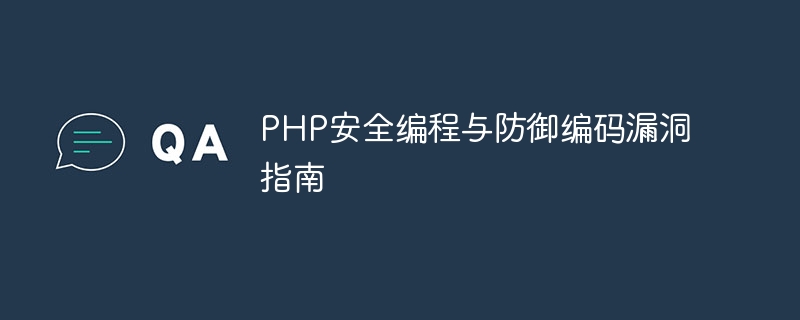

GUIDE TO PHP SECURE PROGRAMMING AND DEFENSE CODING VULNERABILITIES
With the rapid development of the Internet, PHP, as a commonly used server-side programming language, is widely used in Web development middle. However, at the same time, Web security issues have also become an important topic in the Internet world. This article will introduce you to PHP secure programming principles and provide some sample code to defend against common coding vulnerabilities.
filter_var() and preg_match() for verification. For example, if you want to verify an email address, you can use the following code: $email = $_POST['email'];
if (filter_var($email, FILTER_VALIDATE_EMAIL)) {
// 验证通过
// 继续处理
} else {
// 验证失败
// 给出错误提示
}htmlspecialchars() function to convert special characters into HTML entities to prevent them from being interpreted as HTML tags by the browser: $username = $_GET['username']; echo '欢迎,' . htmlspecialchars($username);
$stmt = $pdo->prepare('SELECT * FROM users WHERE username = :username');
$stmt->execute([':username' => $username]);
$result = $stmt->fetch(PDO::FETCH_ASSOC);$allowedTypes = ['image/jpeg', 'image/png'];
$maxSize = 1024 * 1024; // 1 MB
$uploadDir = 'uploads/';
$file = $_FILES['file'];
if (in_array($file['type'], $allowedTypes) && $file['size'] <= $maxSize) {
$filename = uniqid() . '_' . $file['name'];
move_uploaded_file($file['tmp_name'], $uploadDir . $filename);
// 文件上传成功
} else {
// 文件上传失败
}HttpOnly and Secure. The following is an example of setting a Session Cookie:session_set_cookie_params([
'lifetime' => 86400, // 一天
'path' => '/',
'domain' => $_SERVER['HTTP_HOST'],
'secure' => true, // 仅通过HTTPS传输
'httponly' => true // 仅限HTTP访问,无法被JavaScript访问
]);
session_start();function log_error($message) {
error_log($message, 3, 'error.log');
}
try {
// 代码块
} catch (Exception $e) {
log_error($e->getMessage());
// 错误处理逻辑
}To sum up, PHP security programming and defense against coding vulnerabilities require input validation and filtering, output encoding, prevention of SQL injection, file upload and processing, session Start with management and security, logging and error handling. By learning and practicing these secure programming principles, you can improve the security of your web applications and reduce potential risks and vulnerabilities.
The above is a brief introduction and sample code of PHP security programming and defense coding vulnerabilities in this article. I hope it will be helpful to your PHP development work. During the programming process, always keep in mind that security is an important responsibility, minimize all security risks, and ensure the security of user data and systems.
The above is the detailed content of A guide to secure programming and defending against coding vulnerabilities in PHP. For more information, please follow other related articles on the PHP Chinese website!
 currency exchange
currency exchange
 What programs can be developed with php
What programs can be developed with php
 google mailbox suffix
google mailbox suffix
 Comparative analysis of win10 home version and professional version
Comparative analysis of win10 home version and professional version
 How to use countif function
How to use countif function
 How to check memory
How to check memory
 route add command introduction
route add command introduction
 Recommended easy-to-use and formal currency speculation software apps in 2024
Recommended easy-to-use and formal currency speculation software apps in 2024




